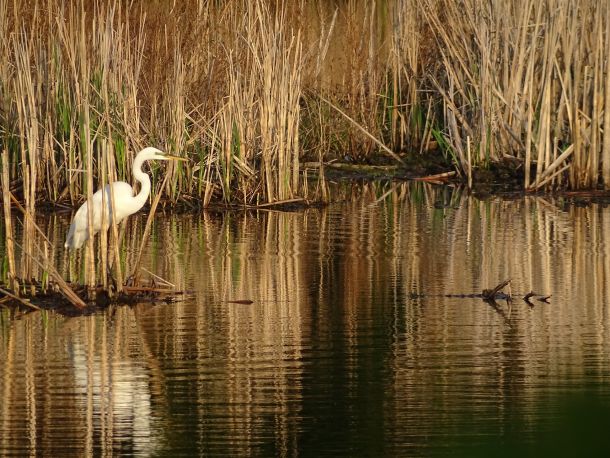Faces of Wetlands: Great Egret
Photo: Allaboutbirds.org
This common member of the heron family is easily spotted along lake shores or flying above wetlands. With a dash of bright white and a slow but powerful wing beat, seeing egrets brings a sense of serenity. Folklore and myth from Egyptian, Celtic, and Native American traditions associate egrets with harmony, balance, diplomacy, patience, and purity. When water in ancient times was closely tied to food and well-being, it makes sense that people would pay close attention to the animals of marshes, rivers, and lakes. These observations brought inspiration and taught us how to adapt to challenges.
The same theme extends to our present day here in North America, but with a modern twist. In the late 19th century, the fashion industry prized egrets. Hats adorned with egret feathers were highly sought for their elegance and striking appeal. A top-of-the-line hat would feature the long plumes that grow from the male egret’s back during the breeding season. As the market sold feathers throughout the US and even Europe, hunters decimated about 95% of their population. For the fashion industry, it was a lesson in balance learned the hard way. For wildlife enthusiasts, it was a lesson in how to balance natural resources before a near extinction. The Audubon Society was founded in 1905 to protect birds like the Great Egret from being killed for its feathers, which is why a Great Egret is their symbol to this day. Continuing the effort, the Migratory Bird Treaty Act of 1918 granted protection to bird feathers, eggs, and nests to over 800 species of non-game birds.
Similar to Blue Herons, Great Egrets nest communally in trees and shrubs along marshes and shallow lakes. Nests can be up to 3’ across and 1’ deep. They’re started by the male before pairing with a female, and if the courtship display goes well, the female may join in to help complete the nest. Baby egrets can be very aggressive and sometimes harm or even kill each other in competition for food, but this instinct also serves to ward off predators.
 Photo: Nick Voss
Photo: Nick Voss
The VLAWMO watershed with its shallow lakes and wetlands has ample habitat for Egrets. Our marshes are great for hunting fish, amphibians, reptiles, snails, small mammals, and invertebrates such as dragonflies. With their long legs and tall, slender neck, egrets can hunt in water as deep as their belly. They slowly wade or stay still until prey wanders into striking range.
While ancient folklore may no longer be our focus, there's still something inspiring about Great Egrets. Spotting one traversing a wetland with its sturdy legs, bright feathers, and expert sense of balance is a nice personal reminder to be patient, seek balance, and adapt to new challenges that always have a way of popping up. Sometimes these small, everyday reminders are the most powerful way to find harmony. Considering the Migratory Bird Treaty Act and the efforts made for bird protection, observation yielded harmony for humans and egrets alike.
Here in VLAWMO Great Egrets can be found on just about any lakeshore. But for the best chances of spotting one, check out the Rotary Park Nature Preserve near Birch Lake, Tamarack Nature Center, or West Vadnais Lake off of the Vadnais/Sucker Lake walking path. To help take care of the egrets in our watershed, visit our webpage to learn more about taking care of our wetlands through low-impact lawn care or adopting a stormdrain.
Find out more about your local lakes and wetlands at www.VLAWMO.org. Read more about egret ecology at the Cornell Lab of Ornithology.
– Nick Voss, VLAWMO Education and Outreach Coordinator
Sources:
www.allaboutbirds.org

